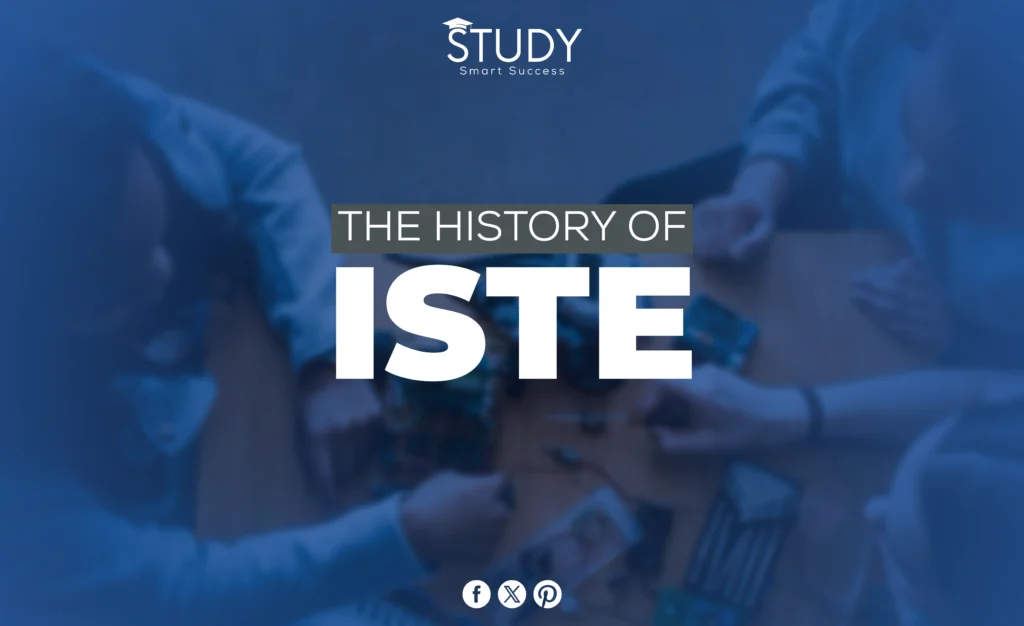Pioneering Educational Technology Advancement
ISTE, or the International Society for Technology in Education, has already made a big difference in how technology and education are used in current situations, and it will continue to do so in the years to come. The ISTE will keep making this kind of effort. When it was first formed in 1979, the International Society for Technology in Education (ISTE) was one of the main groups fighting for technology to be used in schools.
Introduction
The International Society for Technology in Education (ISTE) is an innovation leader in education and technology. Since 1979, ISTE has been improving education through deliberate technology use. This page details ISTE’s history, including its founding, major turning moments, and ongoing impact on education. Join us as we explore ISTE’s amazing story and mission to improve education worldwide.
Here is the Official Website link of ISTE
The Birth of ISTE
In 1979, dedicated, tech-savvy teachers founded the International Society for Technology in Education (ISTE) to improve learning. First, ISTE wanted instructors and students to use technology in the classroom. First, conferences and classes were held to promote educational technology use. A tiny group of leaders with enormous ambitions founded ISTE, which would later become a global powerhouse in educational technology.
Early Initiatives
The International Society for Technology in Education (ISTE) initially promoted computer use in education. This was because computers may change how pupils learn, and professors educate. ISTE took many effective steps to reach this goal. The first things they did were conferences, workshops, and lectures. During these sessions, teachers could share their thoughts and look at the benefits of using technology in the classroom.
- ISTE wanted to educate teachers through these conferences, ensuring they knew about the most recent technology developments and how to incorporate them into their instructional strategies. Providing teachers with the skills and resources they need to utilize these technological advancements fully was more important than just putting computers in classrooms.
- ISTE shaped education technology perception during its early years by encouraging collaboration and knowledge exchange. It set the way for a future where technology will enhance learning for students and teachers.
The Emergence of the Internet
International Society for Technology in Education (ISTE) soon recognized the Internet’s potential as an educational resource after seeing its popularity rise in the 1990s. ISTE began studying the best ways to use Internet resources in education, and during this crucial time, ISTE entered the digital age. In an increasingly linked society, various teaching and learning methods were introduced.
ISTE Standards
The International Society for Technology in Education (ISTE) creates the ISTE Standards. These standards give teachers a clear foundation for using technology in the classroom. They discuss technology-enhanced learning, creative teaching methods, and digital citizenship. In their simplest form, the ISTE Standards guide educators in using technology for education.
Global Outreach
ISTE’s mission strongly emphasizes reaching out to the global community. As time went on, the organization concluded that it was critical to broaden the scope of its effect beyond the borders of the United States. As a result, it began to collaborate actively with academics and organizations worldwide.
- ISTE’s goal was to encourage a more international perspective on educational technology through the organization’s various international partnerships, collaborations, and initiatives. This entailed sharing educational best practices, creative ideas, and answers to problems encountered internationally in the field of education.
- By looking at things on a global scale, ISTE expanded its purpose and helped build a community of teachers and technologists who could work together to improve the use of technology in education around the world. This focus on the whole world is still a big part of ISTE’s work, which encourages sharing ideas and solutions that can help schools worldwide.
The 21st Century Learning Movement
The 21st-century Learning Movement transformed ISTE’s education philosophy. In the 21st century, ISTE realized that education needed to be modernized to match modern needs. The movement sought to foster creativity, communication, teamwork, and critical thinking rather than memorization.
ISTE, the International Society for Technology in Education, promoted these abilities as essential to education. The goal was to equip pupils for today’s jobs and tomorrow’s fast-changing environment. This shift in thinking about education allowed for new teaching methods, digital literacy, and a broader view of what it means to be a well-rounded 21st-century student adept at digital learning.
Annual Conferences
IT and education professionals know about the annual ISTE conferences. Teachers, ed-tech lovers, and innovators from around the world discuss industry developments at these events, which allow professionals to collaborate, discuss best practices, and showcase new ideas.
They provide information and hands-on experience through seminars, events, and lectures to improve school technology. These events demonstrate ISTE’s commitment to sharing knowledge and learning and keeping teachers current on classroom technology.
Digital Transformation
In recent years, ISTE has driven digital education, necessitating a fundamental switch from traditional to digitally enhanced instruction. According to ISTE, technology can make learning more individualized and participative. Many members embrace LMSs, online assessments, and digital teaching materials. ISTE promotes digital change to give teachers powerful technological tools and students the skills and knowledge they need to flourish in the digital age. Innovative classroom technologies strengthen ISTE’s educational leadership.
Advocacy for Equity
ISTE promotes fair technology use in classrooms because it realizes the importance of giving all kids equal access to its benefits. The association supports policies and activities that reduce the digital gap by ensuring equal access to technology and digital learning. ISTE advocates equality beyond access. Digital literacy is included, embracing all and meeting numerous student needs. ISTE advocacy emphasizes a technology-enabled education to ensure no child is left behind in the digital age.
Collaboration with Industry
ISTE’s commercial partnerships have improved school technology. To improve education, ISTE has worked hard to create relationships with key tech businesses. These partnerships have provided new instructional materials, resources, and technology. Professionals help ISTE provide instructors with the latest resources for their requirements and standards. Education companies collaborate to improve learning materials and make new technology easier for teachers and students. It illustrates ISTE’s commitment to smart collaboration and adapting to emerging education tools.
The Future of ISTE
ISTE will continue to work to improve education through technology in the future. It will always be on the cutting edge of new trends, giving teachers the tools to prepare their kids for the future. ISTE will also stick to its commitment to fairness and inclusion by fighting for everyone to have the same access to digital tools. ISTE will continue to set standards, encourage collaboration, and support new ways of teaching to ensure that technology improves education, gives teachers more power, and gets kids ready for success in a world that is becoming increasingly digital.
Conclusion
To sum up, ISTE (the International Society for Technology in Education) has come a long way since its beginning in 1979. ISTE has always used technology to make schools better. It pushed for computers in schools in its early years. It now welcomes the digital age and promotes relationships around the world. Building the ISTE Standards, helping people learn in the 21st century, and being fair have all made it more powerful.
Still, ISTE aims to bring new ideas, make everyone feel welcome, and prepare kids for the future. As a leader and defender with a clear vision, ISTE keeps changing how schools work by making sure that technology improves learning, gives teachers more power, and prepares students for success in a digital world that is always changing.
FAQs
Q1: What is ISTE?
ISTE stands for the International Society for Technology in Education. It’s an organization dedicated to promoting the use of technology in education.
Q2: When was ISTE founded?
ISTE was founded in 1979 by a group of educators and technologists.
Q3: What are the ISTE Standards?
The ISTE Standards provide educators with a framework for effective technology integration in the classroom.
Q4: How does ISTE advocate for equity in education technology?
ISTE actively ensures that all students have access to educational technology, regardless of their background.
Q5: How can I get involved with ISTE?
You can join ISTE as a member and participate in their conferences, workshops, and initiatives.
Q6: What role does ISTE play in addressing the digital divide?
We push for equity in education technology to ensure all students can access digital resources. The organization works with politicians and educators to close the digital gap.
Q7: What is ISTE’s vision for the future of education and technology?
ISTE wants technology to improve learning, empower educators, and teach students 21st-century skills. Through innovation and activism, the organization hopes to shape this future.


